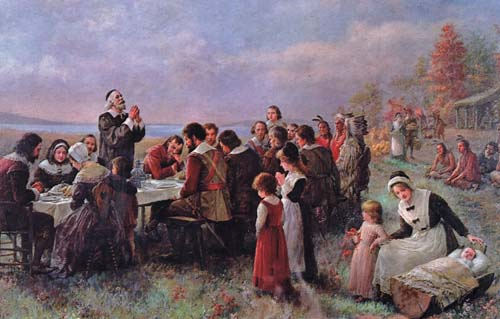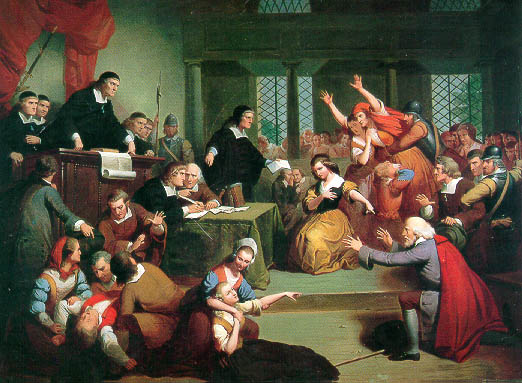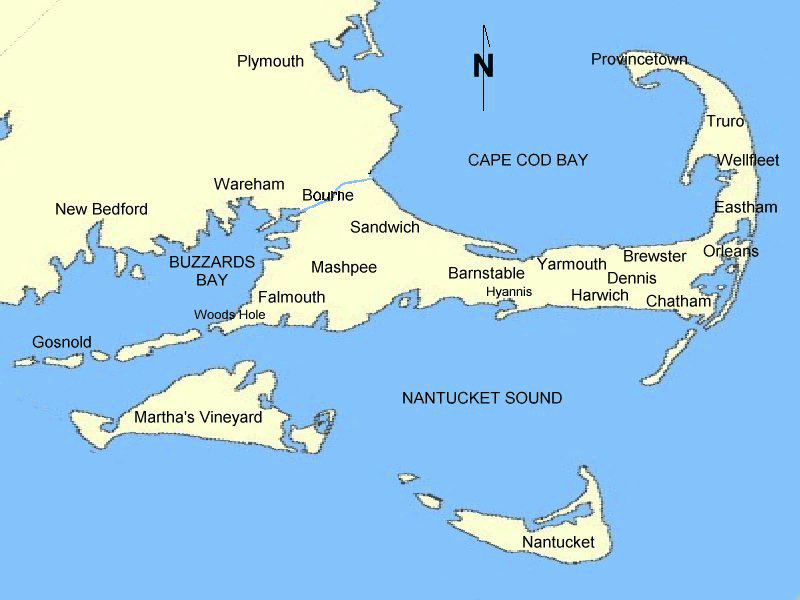 |
Historical Backgrounds Puritans (incl. "The Pilgrims") in England & New England |
 "the First Thanksgiving" |
How does American popular culture remember the Puritans and/or Pilgrims?
![]() "the First Thanksgiving" (Pilgrims)
"the First Thanksgiving" (Pilgrims)
![]() the
Salem Witch Trials (small community of Puritans north of
Boston) + Arthur Miller's The Crucible (1953)
the
Salem Witch Trials (small community of Puritans north of
Boston) + Arthur Miller's The Crucible (1953)
![]() Sexual repression, repression of women, repression of Indians
(all only partly true)
Sexual repression, repression of women, repression of Indians
(all only partly true)
![]() The
Protestant Work Ethic
(which its chief theorist connects chiefly to the Puritans)
The
Protestant Work Ethic
(which its chief theorist connects chiefly to the Puritans)
![]() An old family
with deep, prestigious roots may be said to have "come over on the
Mayflower" (Pilgrims)
An old family
with deep, prestigious roots may be said to have "come over on the
Mayflower" (Pilgrims)
![]() Nathaniel Hawthorne's
The Scarlet Letter
(written 1850, two centuries after setting of story in 1600s)
Nathaniel Hawthorne's
The Scarlet Letter
(written 1850, two centuries after setting of story in 1600s)
![]() The Mayflower Compact written by Pilgrims
studied in History & Political Science as prototype of later
Declaration of
Independence and
U.S. Constitution
The Mayflower Compact written by Pilgrims
studied in History & Political Science as prototype of later
Declaration of
Independence and
U.S. Constitution
Biggest confusion or irony: Many Americans dislike Puritans of the past for being so conservative, especially about private matters like sex, or for religious intensity now associated with fire-and-brimstone fundamentalism, but many Americans (esp. Texans) now dislike New England because it's more liberal than the rest of the USA. How to reconcile these conflicting images?
![]()
b/w Puritans and
Pilgrims?
1619-20 app. 100 "Pilgrims" arrive at
1630s app. 5000 Puritans arrive at
Similarities:
![]() Both groups were members of the same
Protestant movement dissenting from the English or Anglican Church, esp. when the Anglicans
threatened to return to or imitate the Catholic Church (from which the Anglican
Church separated in 1534 under leadership of Henry VIII).
Both groups were members of the same
Protestant movement dissenting from the English or Anglican Church, esp. when the Anglicans
threatened to return to or imitate the Catholic Church (from which the Anglican
Church separated in 1534 under leadership of Henry VIII).
![]() The Pilgrims remained a separate community for a century or so,
but eventually the Puritan community around Boston expanded and absorbed
Plymouth. At such a great distance and time from their origins in England, theological differences between the two groups
are mostly for specialists.
The Pilgrims remained a separate community for a century or so,
but eventually the Puritan community around Boston expanded and absorbed
Plymouth. At such a great distance and time from their origins in England, theological differences between the two groups
are mostly for specialists.
Differences:
![]() The Pilgrims are usually seen as
more
radical Protestants than the Puritans, and since they were smaller in number, in
some regards they resembled something like what today we would call a cult or
associate with other separational movements like the Amish or even the Mormons
(in the 19c).
The Pilgrims are usually seen as
more
radical Protestants than the Puritans, and since they were smaller in number, in
some regards they resembled something like what today we would call a cult or
associate with other separational movements like the Amish or even the Mormons
(in the 19c).
![]() Theologically, the Pilgrims would be called "Separatists,"
indicating their desire to separate entirely from the Anglican Church, which
they saw as beyond redemption. This "separational" identity expressed itself in
their journeys to the Netherlands and North America to find a place of their own
outside the English Church and its society.
Theologically, the Pilgrims would be called "Separatists,"
indicating their desire to separate entirely from the Anglican Church, which
they saw as beyond redemption. This "separational" identity expressed itself in
their journeys to the Netherlands and North America to find a place of their own
outside the English Church and its society.
![]() In socio-economic class, most Pilgrims were working
people—tradesmen like weavers, farmers, or merchants—though the learning of
some of them, especially Governor Bradford, was profound.
In socio-economic class, most Pilgrims were working
people—tradesmen like weavers, farmers, or merchants—though the learning of
some of them, especially Governor Bradford, was profound.
![]() The Puritans were more moderate and
middle-class than the Pilgrims and could thus claim greater numbers—great
enough in England, for instance, to have won the English Civil War of the 1840s.
The Puritans were more moderate and
middle-class than the Pilgrims and could thus claim greater numbers—great
enough in England, for instance, to have won the English Civil War of the 1840s.
Instead of separating from the Anglican Church, the Puritans wanted to reform it from within. (Which they largely succeeded in doing: most of our visions of the Anglican / Episcopalian Church are "High Church" in a way that can resemble the decor and ceremony of the Catholic Church, but most English parish churches are "Low Church" or plainly Protestant.)
Visual Aids
|
The Pilgrims
had the famous "First Thanksgiving" |
The
Puritans
(or a small community of them) |
 |
 |
Pilgrims settled in small-town Plymouth in 1620, Puritans settled in port city Boston in 1630
|
|
|
New England Puritans overall for Americans
![]() Not easy to like but essential to American identity,
political organization, progressive movements, questions of community, and conservative reaction.
Not easy to like but essential to American identity,
political organization, progressive movements, questions of community, and conservative reaction.
![]() Modeled
WASP visual
plain style. (The Puritans are
associated with the 17c Baroque era, but frontier conditions and
middle-class life limited their extravagance.)
Modeled
WASP visual
plain style. (The Puritans are
associated with the 17c Baroque era, but frontier conditions and
middle-class life limited their extravagance.)
![]() Literary connection: Puritans were
highly literate (other
immigrants hit-or-miss, but less so)
Literary connection: Puritans were
highly literate (other
immigrants hit-or-miss, but less so)
![]() Puritans read, wrote, and documented their experiences—organized society
through literacy, left far more written records than other European
immigrant communities.
Puritans read, wrote, and documented their experiences—organized society
through literacy, left far more written records than other European
immigrant communities.
![]() New England as center of American education and
literature: Ivy League; Hawthorne, Emerson, Dickinson, James, Eliot, Frost,
Cummings, Elizabeth Bishop, the Lowells, Thomas Pynchon, many more
New England as center of American education and
literature: Ivy League; Hawthorne, Emerson, Dickinson, James, Eliot, Frost,
Cummings, Elizabeth Bishop, the Lowells, Thomas Pynchon, many more
![]() Model of America as modern middle class nation with
mutual responsibilities rather than rich / poor individualism (as modeled by
Cavalier South).
Model of America as modern middle class nation with
mutual responsibilities rather than rich / poor individualism (as modeled by
Cavalier South).
![]() Americans
think (with some basis) they dislike
Puritans b/c they're "too conservative" on account of repressing sex, not
celebrating Christmas, and hanging supposed witches, but in fact New
England, the home of the Puritans, is the modern center of American
liberalism and the home (with the Progressive midwest) of most American
reform movements, from Abolition of slavery and Woman's Suffrage to
Temperance, Civil Rights, reproductive rights, and universal health
insurance.
Americans
think (with some basis) they dislike
Puritans b/c they're "too conservative" on account of repressing sex, not
celebrating Christmas, and hanging supposed witches, but in fact New
England, the home of the Puritans, is the modern center of American
liberalism and the home (with the Progressive midwest) of most American
reform movements, from Abolition of slavery and Woman's Suffrage to
Temperance, Civil Rights, reproductive rights, and universal health
insurance.
Historical context: The Puritans were a major social and religious movement in England and the United States, but the histories of Puritans in each country plays out very differently:
![]() In North America, the Puritans start out comparatively small
but maintain a long influence as a somewhat unique community and the lasting
center of North American education and stable middle-class culture.
In North America, the Puritans start out comparatively small
but maintain a long influence as a somewhat unique community and the lasting
center of North American education and stable middle-class culture.
![]() In England, the Puritans enact a major, nationwide revolution
that lasts for about 20 years, after which the normal English monarchy is
restored, but with important reforms.
In England, the Puritans enact a major, nationwide revolution
that lasts for about 20 years, after which the normal English monarchy is
restored, but with important reforms.
Where are the Puritans now on the Church map?
![]() From the beginnings until the 1960s, the Trinitarian churches
descended from the Puritans were called "Congregationalist."
From the beginnings until the 1960s, the Trinitarian churches
descended from the Puritans were called "Congregationalist."
![]() In the late 1700s and early 1800s, many Congregational
churches became Unitarian churches.
In the late 1700s and early 1800s, many Congregational
churches became Unitarian churches.
![]() In the 1960s the Congregational Church joined with the
Reformed and Evangelical Church and two smaller denominations to form the United
Church of Christ (of which former President Obama is a member).
In the 1960s the Congregational Church joined with the
Reformed and Evangelical Church and two smaller denominations to form the United
Church of Christ (of which former President Obama is a member).
![]() These churches are low in numbers but comparatively
influential because of high education levels.
These churches are low in numbers but comparatively
influential because of high education levels.
![]()
Puritans in English History
Familiar figures and dates (These people weren't Puritans but lived in same time periods.)
Henry VIII 1509-47
Shakespeare 1564-1616
Queen Elizabeth I 1533-1603
Stuart Kings—James I 1566-1625
Charles I 1600-1649 (executed by Puritans during English Civil Wars)
English Civil Wars 1640s
Political battle b/w Parliament (Puritans, emerging middle class) & King (Royalists, aristocracy)
>
Only period of English history w/o king
some millennial effort to restore “godly kingdom”
leadership problems > “Restoration” of Charles II to throne
But Parliament prevailed: “Constitutional Monarchy”
Consequences of Puritans for England: mostly political--parliament increasingly powerful, monarchy increasingly weak
In America, however, the Puritan effort remained strong both politically and culturally
Politically: Puritans as strong larger community rather than anti-government individualism
Culturally--2 diverse influences
Most progressive political movements like Abolition, Woman's Suffrage, progressive taxation, peace movements, health care reform, and public education have originated in or been supported by New England
Puritan attention to family love, patriarchal responsibility, monogamous covenant marriage, child discipline (which meant training, not hitting) have had strong influence on evangelical churches, cultural conservatives, and family values.
American Puritan Generations
Regardless of modern people's indifference to or disdain for the Puritans, their abundant literature and carefully recorded history provides an important research base for analyzing historical and continuing trends in American culture and history.
The Puritans themselves were acutely aware of their own history, seeing it as a stage on which God's plan for the world played out.
1st Generation: Pilgrims (Bradford) and Puritans (Winthrop) represent original American community based on covenant of mutual support and obedience to God modeled on "primitive church" or Apostolic generation after Christ. (But that community is already disintegrating by end of Of Plymouth Plantation.)
2nd Generation: (Captivity of Mary Rowlandson) Frontiers of Puritan community under threat by outsiders (American Indians as terrorists), being tested. What is God's plan?
3rd Generation: Salem Witch Trials: Covenant community under threat from inside. Mather: "A Horrible PLOT against the Country by WITCHCRAFT." Religion becomes self-destructive, and people back off from religious passion and conflict.
4th Generation: Jonathan Edwards, (1st) Great Awakening as "revival" or attempt to restore earlier covenant community in increasingly secular world.
Overall pattern:
1. unity with God and each other (cf. Genesis, Garden of Eden, Adam & Eve)
2. persecution, corruption by external & internal enemies
3. revival or attempt to restore earlier community despite changing conditions or shakiness of original community (Edwards, to his credit, attempts to adapt religion to science, or absorb scientific learning into religion, but too great a challenge for others to imitate.)
Recent rough analogies:
![]() 9/11 as
invasion / conspiracy of outsiders > United We Stand! [> Tax cuts for rich,
Afghan and Iraqi Wars]
9/11 as
invasion / conspiracy of outsiders > United We Stand! [> Tax cuts for rich,
Afghan and Iraqi Wars]
![]() "Make America
Great Again" as revival of earlier, mythic time of white unity, resistance to
tolerance, diversity, global consciousness
"Make America
Great Again" as revival of earlier, mythic time of white unity, resistance to
tolerance, diversity, global consciousness
![]() President
Obama's return to Civil-Rights-Era rhetoric to recreate diverse but unified
America.
President
Obama's return to Civil-Rights-Era rhetoric to recreate diverse but unified
America.
![]() Bernie
Sanders's appeal to return to New Deal-era taxation on rich, support for middle
class
Bernie
Sanders's appeal to return to New Deal-era taxation on rich, support for middle
class

The Puritan Influence:
Conservative or Liberal?
Conservative:
·
Nuclear family
as "household of God." (Think "family values.")
·
Image
of Puritans as
sexual prudes. ("Banned
in
·
Bible as record of God's movement in
human history;
·
Many conservative
religious movements branched off, descended
from, or developed alongside Puritanism:
Baptistry
(Roger Williams of
·
Capitalism grows
especially well in Puritanism. (Think "Yankee
ingenuity" and "Yankee peddlers" in American history. The Allen Brothers who
originally developed
Liberal:
·
Yearning for tight-knit larger community, rather than pure
individualism. (Think President Clinton's
interpretation of "government" as "community.")
·
Limitations,
regulations, and taxes on business. (Think
"blue laws" deriving from Puritan emphasis on Sabbath.)
·
Priority of public
education, with eventual availability to women
as well as men. (Think of the
"Ivy League" of Yale,
Harvard, Brown, and other outstanding liberal arts colleges and universities in
·
New England as
source of most
·
·
The
most liberal
church denominations in the
·
New England as source of
greatest and most unbroken tradition in American literature: Bradstreet, Taylor,
Edwards, Franklin, Emerson, Thoreau, Fuller, Dickinson, Henry James, Edwin
Arlington Robinson, Robert Frost, Wallace Stevens, e e cummings, Elizabeth
Bishop, Robert Lowell, Sylvia Plath, Anne Sexton, Thomas Pynchon, and many more.
![]()

